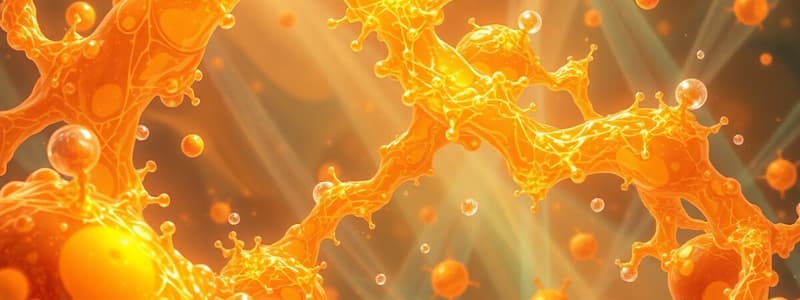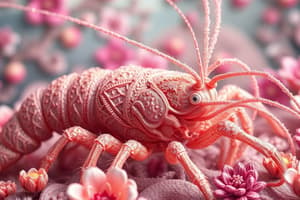Podcast
Questions and Answers
What characteristic of the polymers discussed contributes to their potential use in physiological applications?
What characteristic of the polymers discussed contributes to their potential use in physiological applications?
- Poor bio-compatibility
- High toxicity
- Limited biological activity
- Complete biodegradability (correct)
Which chemical structure is a primary component of chitin?
Which chemical structure is a primary component of chitin?
- Cationic branched polymer
- Linear cationic heteropolymer (correct)
- Polysaccharide with α-1,6-linkages
- Random helical polymer
What is the main functional group associated with the stability of thiol groups?
What is the main functional group associated with the stability of thiol groups?
- Amino groups
- Carboxylic groups
- Sulfhydryl groups (correct)
- Hydroxyl groups
What type of linkage connects the residues in chitin?
What type of linkage connects the residues in chitin?
What is a common reaction condition necessary for the synthesis of chitosan derivatives?
What is a common reaction condition necessary for the synthesis of chitosan derivatives?
The formation of disulfide bonds mainly involves which element?
The formation of disulfide bonds mainly involves which element?
Which property of chitosan derivatives contributes to their versatility in biological applications?
Which property of chitosan derivatives contributes to their versatility in biological applications?
Which bio-component is chitin primarily derived from?
Which bio-component is chitin primarily derived from?
Which chemical modification technique involves the addition of a thiol group?
Which chemical modification technique involves the addition of a thiol group?
What is a potential application of chitosan derivatives in various fields?
What is a potential application of chitosan derivatives in various fields?
Which among the following modifications is likely to enhance solubility in chitosan?
Which among the following modifications is likely to enhance solubility in chitosan?
Formation of which compound is indicative of a successful thiolation reaction?
Formation of which compound is indicative of a successful thiolation reaction?
Which of the following modifications would likely improve the multifunctionality of chitosan?
Which of the following modifications would likely improve the multifunctionality of chitosan?
Under what conditions are most chemical modifications of chitosan typically performed?
Under what conditions are most chemical modifications of chitosan typically performed?
Which term describes the effectiveness of chitosan derivatives in different applications?
Which term describes the effectiveness of chitosan derivatives in different applications?
Which chemical modification technique is primarily focused on adding a functional group to enhance reactivity?
Which chemical modification technique is primarily focused on adding a functional group to enhance reactivity?
What is a primary concern regarding the stability of thiol groups in chitosan derivatives?
What is a primary concern regarding the stability of thiol groups in chitosan derivatives?
Which technique is commonly used for the chemical modification of chitosan to enhance its properties?
Which technique is commonly used for the chemical modification of chitosan to enhance its properties?
What are typical reaction conditions necessary for the synthesis of chitosan derivatives?
What are typical reaction conditions necessary for the synthesis of chitosan derivatives?
What is essential for the formation of disulfide bonds in chitosan derivatives?
What is essential for the formation of disulfide bonds in chitosan derivatives?
Which property is enhanced in chitosan derivatives modified with carboxyalkyl groups?
Which property is enhanced in chitosan derivatives modified with carboxyalkyl groups?
Which factor does NOT significantly influence the mechanical properties of chitosan derivatives?
Which factor does NOT significantly influence the mechanical properties of chitosan derivatives?
Thiolated chitosan is expected to have which characteristic that differentiates it from non-thiolated chitosan?
Thiolated chitosan is expected to have which characteristic that differentiates it from non-thiolated chitosan?
Which modification could be expected to improve the adsorption capacity of chitosan derivatives?
Which modification could be expected to improve the adsorption capacity of chitosan derivatives?
Flashcards are hidden until you start studying
Study Notes
Chitin and Chitosan Chemistry
- Chitin is the second most abundant biopolymer
- Chitin is found in crustacean exoskeletons and in fungi and insect cell walls.
- Chitin is a linear cationic heteropolymer with a b-1,4-linkage
- Chitin is composed of randomly distributed GlcNAc (N-Acetylglucosamine) and GlcN (Glucosamine) residues.
- Chitosan is derived from chitin by deacetylation
- Chitosan is a valuable biomaterial due to its biocompatibility, complete biodegradability, and low toxicity.
- Chitosan is often derivatized to enhance its properties and expand its applications.
Chitosan Derivatives
- Quaternized chitosan and N-alkyl chitosan are examples of highly cationic derivatives.
- Hydroxyalkyl chitosans have increased water solubility and biocompatibility.
- Carboxyalkyl chitosans have improved hydrophilicity and biodegradability.
- Sugar-modified chitosans can be engineered to target specific cell receptors.
- Cyclodextrin linked chitosans exhibit enhanced drug delivery properties.
- N-Acyl chitosans have improved biocompatibility and drug encapsulation abilities.
- O-Acyl chitosans have altered solubility and biodegradability profiles.
- Thiolated chitosan can form disulfide bonds with other molecules.
- Sulfated chitosans have increased anti-coagulant properties.
- Azidated chitosans can be used for click chemistry reactions.
- Phosphorylated chitosans have potential for gene delivery applications.
- EDTA–chitosan exhibits metal chelating properties.
- Thiourea derivatives of chitosan show enhanced antimicrobial activity.
Modifications of Chitosan
- Modification of chitosan includes oligomerization, alkylation, acylation, quaternization, hydroxyalkylation, carboxyalkylation, thiolation, sulfation, phosphorylation, enzymatic modifications, and graft copolymerization.
Potential Applications
- Chitosan derivatives may find applications within pharmaceutical, biomedical, and biotechnological fields.
- Hybrids of chitosan with sugars, cyclodextrins, dendrimers, and crown ethers are also interesting candidates for multifunctional applications.
Studying That Suits You
Use AI to generate personalized quizzes and flashcards to suit your learning preferences.




